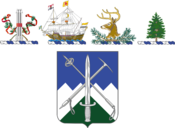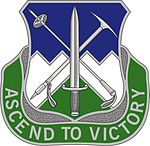172nd Infantry Regiment (United States)
| 172nd Infantry Regiment | |
|---|---|

Coat of arms
|
|
| Active | 1982 |
| Country |
|
| Allegiance | Vermont, Maine, New Hampshire and Rhode Island |
| Branch | Vermont Army National Guard |
| Type | Infantry |
| Role | Mountain Warfare |
| Part of | 86th Infantry Brigade Combat Team (United States) |
| Motto(s) | ASCEND TO VICTORY |
| Colors | Blue |
| Insignia | |
| Distinctive unit insignia |  |
| U.S. Infantry Regiments | |
|---|---|
| Previous | Next |
| 169th Infantry Regiment | 175th Infantry Regiment |
The 3rd Battalion, 172nd Infantry Regiment (Mountain), also known as the "Mountain Battalion", is a Vermont/New England Army National Guard light infantry battalion which specializes in mountainous and cold weather operations. The unit falls under the command of the Vermont Army National Guard's 86th Infantry Brigade Combat Team (Mountain).
Before the creation of the 86th IBCT (MTN) in 2008, 3-172 IN (MTN) was recognized as the only conventional unit in the United States Army trained and equipped for mountain operations. 3-172 IN (MTN) draws strong heritage from the original 10th Mountain Division (Alpine) of World War II fame both in the type of training they conduct and in the specialized equipment the unit maintains.
The initial assignment of the '172nd' designation to a unit of the Vermont National Guard by the War Department can be traced to 1 October 1921, when the 1st Infantry of Vermont was redesignated the 172nd Infantry and assigned to the 43rd Division. The regiment served with the 86th Infantry Brigade of the 43rd Division from 1922 to 1941.
The regiment was inducted into federal service on 24 February 1941 and was organized as a Regimental Combat Team for service in the Pacific. The new RCT comprised the 172d Infantry Regiment, the 103d Field Artillery Battalion and elements of Ordnance, Engineer, Medical and Signal units. The 172nd RCT almost saw disaster at Espiritu Santo, New Hebrides on 26 October 1942, when its troop transport, the liner SS President Coolidge, struck two U.S. mines in the harbor. The captain, realizing that the ship was lost, attempted to run it aground so that the troops could disembark. The ship sank, but the regiment got ashore with few casualties, to fight in the New Georgia Campaign, including during the Drive on Munda Point.
...
Wikipedia
